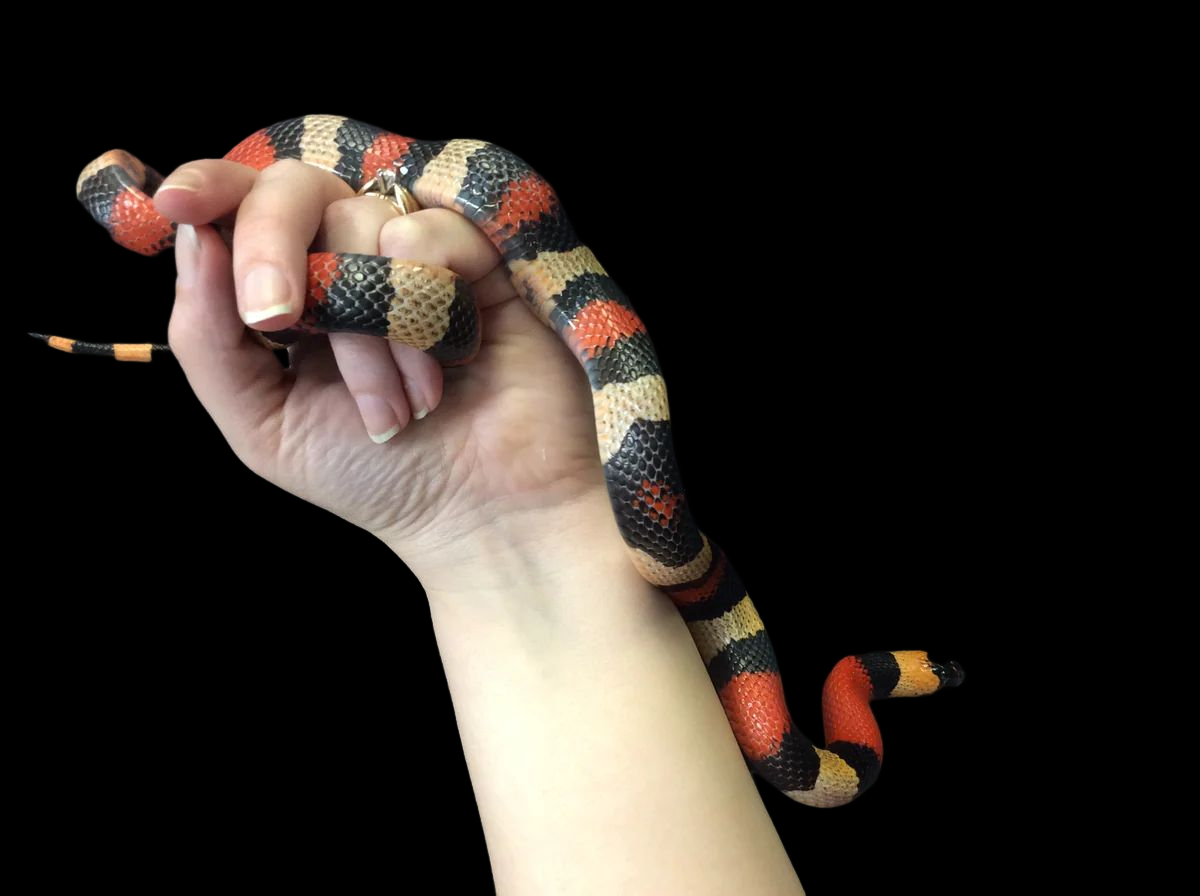Photo Disclaimer
Description
Pueblan Milksnake (Apricot)
Scientific Name: Lampropeltis triangulum campbelli
Common Name: Pueblan Milksnake
Species Overview
Size: Adults typically reach 3–4 feet (0.9–1.2 m) in length, with a slender, smooth body and glossy, reflective scales.
Appearance: The Apricot Pueblan Milksnake is a selectively bred colour line known for its rich, orange-based tones and soft contrast. This morph enhances the red pigmentation of the traditional tri-coloured pattern, replacing the bright red bands with vivid apricot-orange and soft peach hues. The black banding remains present but reduced, giving a smoother transition between colours and a slightly warmer overall appearance. The white or yellow bands shift toward creamy tones, creating a more natural, sun-warmed palette. Mature individuals often display deeper orange tones with age, maintaining a clean, even contrast across the entire body. The result is a bright yet balanced morph that stands out while retaining the classic banded pattern of the Pueblan Milksnake.
Distribution: Originates from selective captive breeding of the Pueblan Milksnake, a subspecies native to southern Puebla, Mexico.
Habitat: Pueblan Milksnakes inhabit dry forests, scrublands, and rocky grasslands in central Mexico. In captivity, this morph thrives in naturalistic terrariums with soft substrate, climbing branches, and secure hiding areas.
Behaviour: These snakes are confident and alert but typically calm with regular handling. They are hardy, excellent feeders, and well-suited for both display and breeding programs.
Captive Care
Enclosure: Provide an enclosure at least 3–4 feet in length for adults. Include multiple hides, smooth décor, and climbing structures. A naturalistic substrate such as soil, coconut fibre, or aspen allows burrowing and helps regulate humidity.
Temperature & Humidity: Maintain a daytime gradient of 78–85°F (25–29°C) with a basking area near 88–90°F (31–32°C). Allow nighttime drops to around 70°F (21°C). Maintain humidity between 50–65%, offering a humid hide during shedding.
Diet: Offer frozen-thawed rodents every 7–10 days for juveniles and every 10–14 days for adults. Pueblan Milksnakes are consistent feeders with strong feeding responses.
Behaviour in Captivity: Active, curious, and manageable, these snakes thrive under consistent husbandry. Their vibrant coloration and adaptability make them popular among both hobbyists and breeders.
Special Considerations: Milksnakes should always be housed individually, as they may consume other snakes.
Genetics Note
Apricot (Polygenic Selective Trait): A selectively bred line developed to enhance the orange and peach pigmentation of the red bands while softening the white and yellow tones. The black bands are slightly reduced through line breeding, resulting in a smoother, warmer appearance.
Polygenic Nature: The Apricot trait is not controlled by a single gene but by selective breeding across multiple generations to emphasize red-orange pigmentation and minimize black contrast. Expression varies, with some individuals displaying bright citrus tones and others developing deep coppery hues.
Genetic Combination Summary
The Pueblan Milksnake (Apricot) expresses a polygenic, selectively bred colour enhancement:
-
Apricot (Polygenic): Increases red-orange pigmentation and reduces black band intensity, producing a warmer, peach-toned appearance.
This colour line highlights the natural beauty of the Pueblan Milksnake while offering a soft, balanced palette distinct from other high-contrast morphs. The Apricot Pueblan Milksnake is valued and highly regarded for its vivid yet natural aesthetic, making it a favourite among collectors seeking refinement without extreme alteration of the species’ classic pattern.

